The world of colors is so diverse that sometimes it is very difficult to choose the brightest and unusual instances for yourself. All gardeners want to find exactly the "her" flower, which is distinguished by bright flowering, unpretentious in leaving and long flowering.
Most often, preference is given to more familiar colors, the peculiarities of the cultivation of which are understandable and simple. However, today there are flowers in nature that simply amazing the imagination with their beauty. But their cultivation causes some difficulties. Such plants include alstromeria - the Inca flower, which can so often be found in flower shops in bright and gentle bouquets. In the world, the most beautiful flower in tradition is the rose - alstroemeria is not inferior to her beauty. And putting a little effort, you can grow this overseas miracle at home.
In this article, we will consider the features and description of Alstromeria, we describe its main types and varieties. And also highlight the nuances of agrotechnics of growing alstromeria in the open ground, at home and greenhouse.
Features and description of alstromeria
Alstromeria is a rhizable perennial herbaceous plant, which refers to the family of the family and the genus of Alstromeria. In the gardens on flower beds or flower beds, this plant is found very rare, most often this gentle flower can be purchased in flower shops. The natural area of \u200b\u200bthe habitat of Alstromeria is the territory of South America, and more precisely, such countries as Chile and Peru. It is in these country that Alstromeria flowers can be found on the roads of the roads, on wasteland, just like dandelions grow.
This flower is known for a long time. In the ancient tribes of Indians, Inca Alstromeria was worshiped as a flower of gods. No wonder this plant vested magic properties. Nowadays, Alstromeria is considered a symbol of good luck, prosperity, friendship and wealth.
When the Inca Indian sites began to master the Spaniards, Alstromeria's flower got into Europe, or rather to Spain. First, few people paid attention to him. While traveling in Spain, Clas Alstremer did not notice a small and gentle flower, whom he had seen before. The scientist sent a detected flower of Karl Linneu, which was engaged in the systematization of plants. It was the linen that he took him to a separate family and called in honor of his friend Botany, Zoologist Claus Alstremer.
In its appearance, alstromeria flowers resemble lilies or loyers, so very often in the people this plant is called "Peruvian Lilia" or "Lilia Incov".
Description Alstromeria:
- Alstromeria is only a perennial plant.
- The root plant system is represented by the rhizome, which has the form of spindle. It is very branched and contains a large number of starch.
- Alstromeria is a herbaceous plant, the stems of which are very flexible and reprehension.
- In the altitude of alstromeria grows from 80 cm to 150 cm.
- This plant forms two types of shoots: vegetative (the presence of large leaves collected on the top) and reproductive (small leaves are evenly located on the stalk).
- Pretty unusual leaves from this plant. During growth, they turn around the axis - in science it is called the term restoration. Degree rotation of the leaves about 180 degrees. On the flower leaves can be seen the bottom plate up.
- Leaves have a bright green shade.
- Alstromeria flowers have a small size, just 5 cm in diameter.
- In shape, they resemble lilies or, as this form wears the name in Science, Zigomorph.
- All flowers are collected in large and rare umbrellas, which consist of 10-30 inflorescences.
- Alstromeria bloom begins in the late spring or early summer.
- Alstromeria colors are so diverse that you will choose your own shade without any problems. Most often they are red, yellow and pink. Some varieties have flowers or stripes.
- These plants are easily pollinated by insects.
- Most often, Alstromeria is grown on an industrial scale in greenhouses for sale, but you can decorate the garden or room with this plant.
- The fruit of the plant is a box with seeds that are crumbled around the flower when ripening.
Variety of types and varieties of alstromeria
Today in the world there are several dozen species of alstromeria, which differ in different heights of the stem, coloring colors and the peculiarities of growing. The breeders of the whole world have replaced a large number of species varieties and hybrids. Since the alstromeria flower is considered a thermo-loving plant, scientists try to bring more stable varieties to our climatic conditions. Consider the most common types and varieties of Peruvian Lily.
Alstroemeria Golden (Alstroemeria Aurea)
- The natural habitat of this type of alstromeria is the alpine areas of Chile.
- This is a rather high plant, which can be 150 cm in height.
- Golden alstromeria flowers have a different color: it varies from a golden yellow shade to bright orange.
- The main feature of this type of Peruvian lily is relative frost resistance. Alstromeria Golden puts out frosts up to minus 12 degrees.
- Thanks to the endurance, this type of plant is perfect for growing in our climatic conditions.
Brazilian alstromeria:
- It is a Brazilian view of this flower.
- It can be attributed to tall plants that can grow to 1.5 m in height. Some plants reach 2 m.
- A distinctive feature of this type of alstromeria is a spear shape of the petal.
- Color painting is red or bronze.
Alstromeria Nano:
- This plant is a Peruvian view.
- Alstromeria nano is distinguished by low growth, the stalks in height reach only 10 cm.
- Flowers have a bright golden shade with black spots.
- A large number of bright colors usually appear on a small plant.
Alstromeria Blood-Flower:
- The natural habitat of this type of Alstromeria is South America, namely the territory of Chile and Peru.
- Different with rapid growth.
- The root system is represented by a rather fleshy root.
- Alstromeria Blood-Red is valued for lush flowering. On the plant simultaneously appears about 15 colors of the bright red shade.
Alstromeria Psittacina:
- The natural area of \u200b\u200bhabitat is the territory of Argentina.
- The main value can be called Flowers of unusual color. During flowering, the plant is covered with bright orange flowers with a green border along the edge of the petals.
Popular alstromeria varieties and hybrids:
- Alstromeria "Cosmo". This variety belongs to tall plants. I am striking the beauty of snow-white colors, which thick cover all the plant.
- Sort "Alicia". Also a rather popular variety of plants. The two-color coloring colors is characterized. Alstromeria "Alicia" blooms white and pink flowers.
- Alstromeria "Virginia". In the height, this plant reaches an average of 80 cm. Perfectly feels in light shading. Blossom begins in early June. It blooms this alstromeria variety with large white shade flowers with a wavy edge.
- Grace variety. Tall grade plant, the average height from 150 cm to 170 cm. Blossom starts in the spring, and under favorable conditions can bloom again. Flowers lilac, less common - with a purple tinge.
- Alstromeria "Harmony". A tall and powerful plant, which in height can grow an average of 160 cm. It blooms twice for the season: in April and in September. Bronze shades with black strokes on petals.
- Sort "Canary". Powerful plant whose height reaches 1.5 m or more. It blooms twice the season: the first time in March. And the second is in the first half of autumn. Judging by the title, the flowers have a bright canary shade with barely by-catchful black speck.
- Grade "King Cardinal". Average plant with pretty large blonders. It is distinguished by long blossom, from the end of spring to the first frosts. Flowers with large red colors similar in shape on orchids.
Alstromeria reproduction: the most common ways
Alstromeria can be independently distributed on its site. To do this, it is necessary to determine the method suitable for you. This plant breeds in two ways: seeds and fission of rhizomes. Both paths are distinguished by their peculiarities and difficulties, but with due attention and efforts you unconscable this amazing plant without problems.
Seed reproduction
- The cultivation of alstromeria from seeds is possible for species, as hybrid plants can lose their maternal signs.
- If you want to collect seeds yourself, consider that after ripening the fruit cracks and the seeds are scattered around the plant. To collect, you can wrap a swarm bout to wrap a piece of gauze to fall that the seeds fall there.
- Before sowing seeds of Alstromeria, it is necessary to subjected to stratification. To do this, place them in a wet fabric and put in the refrigerator at a temperature of 2-5 degrees for 1 month.
- Seed seeds need at the end of February or in early March. In this case, you will receive seedlings for landing into an open ground.
- After stratification, prepare containers with fertile soil, moisturize it and place the seeds to depth no more than 1 cm.
- From above, the containers are covered with glass or film.
- To germinate seeds, the optimal temperature of 18 degrees.
- Seedlings appear during the month. After the appearance, they have 3 leaves be sure to dive seedlings.
- In the open soil seedlings plant in the late spring.
- Planted alstromeries from seeds will bloom only for 3 years.
Reproduction of rhizome division
- With this method, hybrid varieties of alstromeria are most often multiplied.
- A planted plant with division will bloom the next year.
- Conduct the root of the root is necessary after flowering. However, many gardeners make it in the fall, and in the spring, and in the summer.
- Gently dig a alstromeria bush. Watch that the roots of the plant are not damaged.
- Specialists recommend dividing rhizome to a small number of parts, a maximum of 2-3 parts.
- Each part must have a fairly strong and powerful root system.
- Sections of sections must be treated with a special disinfectant solution or charcoal.
- Alstromeria seedlings are needed immediately after division.
- Alstromeria plants divided by this way will take quite a long time, so they need constant care.
Stages of preparation before landing Alstromeria
Alstromeria is an exotic plant, so requires a serious relationship and attention. It is important to carefully prepare before landing. To do this, you need to choose healthy altersomery seedlings, pick up the right place on the site or find the perfect plants of the room pot. It is also important to properly prepare the soil.
Stage 1. Selection of Alstromeria varieties and seedlings
- Alstromeria is a thermo-loving plant, she needs a warm climate with soft winter. However, there are varieties that can withstand small frosts with shelter.
- Currently, breeders were displayed for the middle strip.
- To buy alstromeria is best in specialized stores or agrofirms, which are professionally engaged in breeding plants.
- While buying a landing material of Alstromeria, choose only varieties adapted to the climatic conditions of your region. Consultant can be asked about the peculiarities of growing individual varieties.
- You can acquire the seedlings of Alstromeria or its seedlings.
- Before buying, carefully inspect the seedling. It should not be visible damage, as well as signs of diseases and pests.
- Different varieties of alstromeria have different heights, so before buying, decide on the planned garden composition. More lowered varieties are perfect for growing in containers or indoor pots.
Stage 2. Selection of Places for Landing
- Alstromeria can be grown in greenhouses or greenhouses, as well as in the pots indoors. More frost-resistant varieties can be grown in the open ground in the middle lane of Russia and the CIS countries.
- The low-spirited varieties, such as Alstromeria Nano, are great for growing in the opponents, which can be placed on the site, and for the winter to enter the loggia or greenhouse.
- Tall varieties are suitable for growing in flower beds and flower beds.
- For landing Alstromeria, warm and solar places are excellent. However, the sun should not heal too much. For full growth, it is better to create a light mandatory.
- The selected plot should be protected from strong winds and drafts.
Stage 3. Choice and soil preparation
- For the growth of alstromeria, weakly acidic or neutral soil is suitable.
- The soil should be light and nutritious. Skinny or clay soils are suitable.
- The landing place should be dried and well drained.
- If the soil is heavy on your site, Alstromeria will grow badly. In this case, before boarding, add peat, overwhelmed manure.
- Over the day before planting the plant, the selected area is thoroughly reappear, shuffle the soil and add compost.
Landing Technology Alstromeria in Open Soil
- Landing alstromeria in open ground is carried out in the spring, approximately in May, when air and soil warm up to 20-23 degrees.
- The day before landing seedlings, shry the soil on the selected area, as the plant prefers to grow on light ground.
- Next, it is important to properly make the landing wells that should be at a sufficient distance from each other. The root alstromeria system is very quickly growing and the plants may interfere with the neighboring.
- Landing Pits for Alstromeria should be about 60 cm in diameter and 35-40 cm in depth. Between the wells, leave the distance at least 50 cm.
- At the bottom of each well, place a layer of drainage from small stones or gravel. It is necessary to prevent water stagnation at the roots of the plant.
- Next to each well add a handful of overworked compost.
- Place the plants in the pits and gently sprinkle the soil, slightly sealing the soil with your hands.
- After planting abundantly, bypass every plant with water.
- It is recommended to inspire the soil around the plant to prevent the evaporation of moisture and in order to preserve the looseness of the site. The mulch is used peat or dry sawdust.
Agrotechnics of growing alstromeria in the open ground: Secrets and nuances of care
Alstromeria requires some attention and care efforts. The process of caring for alstromeria includes watering, loosening, feeding and shelter for the winter. Consider the features of each process separately.
Watering Alstromeria
Alstromeria does not tolerate too risen or overwhelmed soil, so it should be carefully related to the irrigation regime. Watering the plant is needed regularly, but moderately. You should not overflow, since the root system of the plant can start rotting. Approximate scraper schedule - 1 time per week. In arid periods - 2 times. The soil around the plant should always be slightly humid, about 2 cm in depth. In case of non-compliance with the mooring mode of Alstromeria, decorative can be lost.
Loosening and mulching
After each watering the soil around the plants, it is necessary to loose, as Alstromeria prefers to grow on lungs and air soils. During loosening, remove all weeds. An important step in caring for this plant is mulching. So that the land remains loose as long as possible, the rolling circle can be filled with mulch. As a mulch, use peat, dry sawdust or bark of trees.
Podchar
The first feeding is made during the landing. This uses compost. In the future, it is necessary to regularly feed the plant to obtain lush flowering and bright foliage. Fertilizers need to be made approximately 3 times a month. Used or mineral complex fertilizers, or organic. During vegetation, it is best to use fertilizers with a large content of nitrogen. During the appearance of buds and fertilizer colors should contain phosphorus. Periodically, you can plug the wood ash under the plants.
Trimming and shelter
During flowering, it is recommended to remove the sworded buds. It will stimulate the growth of new and more lush flowering. Before the onset of the cold, the upper part of the plant must be trimmed, and the root system is to cover. To do this, the peat that fell foliage and the laps is used. From above can be covered with also bypass material. In the spring, all this is removed.
Fighting diseases and pests
Alstromeria is distinguished by relative resistance to disease and pests. However, with no observance of the rules of irrigation, the plant may be affected by gray rot. To combat it, a solution of fundamental or fungicide is used.
The plant is sometimes amazed by slugs and caterpillars, to collect which is better manually. Against the pests as a web tick, the trips are better to use special preparations - accility.
Growing Alstromeria in Teplice
- Alstromeria is most often grown in greenhouses on an industrial scale for cutting.
- Before boarding the greenhouse, carefully prepare the soil, which should consist of peat, sand, deciduous land and humus. Everything needs to be carefully overcooked.
- Also before landing alstromeria to the greenhouse, the soil can be treated with a disinfectant.
- When landing, you can use a mesh that is placed on top to the surface. It is needed to support adult plants.
- Temperature in Teplice: During the growth of foliage - 15 degrees during the day and 13 at night, during the flowering of the plant - 18-20 degrees. If the plant is grown in a greenhouse constantly, in the winter the temperature should be no lower than 10 degrees.
- Care. Timely and regular watering in the greenhouse reaches a drip method. In this winter, watering should be reduced. Periodically need to loosen the soil near the plants. The feeders are entered twice a month. For this, nitrogen-potash fertilizers are used. In winter, alstromeria requires additional lighting.
Growing alstromeria at home
Alstromeria can be grown at home, but it is necessary to know some subtleties.
- The root plant of the plant is long enough, so it is necessary to choose a spacious pot. Its depth should be at least 25 cm.
- Be sure to do the hole at the bottom of the pot.
- For optimal growth of alstromeria in the room you need to choose the right place. The location is perfect, where half a day shines the sun and half a day. Easy shadow.
- At home, it is necessary to water alstromeria once every 3 days.
- Plant fertilizer in room conditions do not require.
Using Alstromeria in Landscape Design
Alstromeria is a very beautiful and bright plant, which recently begins to be used to decorate the site.
- Alstromeria is grown for cutting in bouquets.
- The lowest varieties of this plant are perfect for the framing of borders and garden tracks. Low alstromeria can be landed on flower beds next to other blooming plants.
- Tall alstromeria can be placed in the background of flowerbed or plant a group on the background of lawn.
- Low color flowers are often grown in containers and pots and place them on verandas, balconies and steps.
Photo Alstromeria
It is possible to more clearly see all the beauty and options for using alstromeria in the photo presented below.
Gorgeous bouquets of alstromeria
Alstromeria in Gord
Alstromeria is a rather exotic plant that requires attention and care. However, you should not be afraid, while complying with all the rules you will get a beautiful plant that is pleasing to all with your lush flowering.

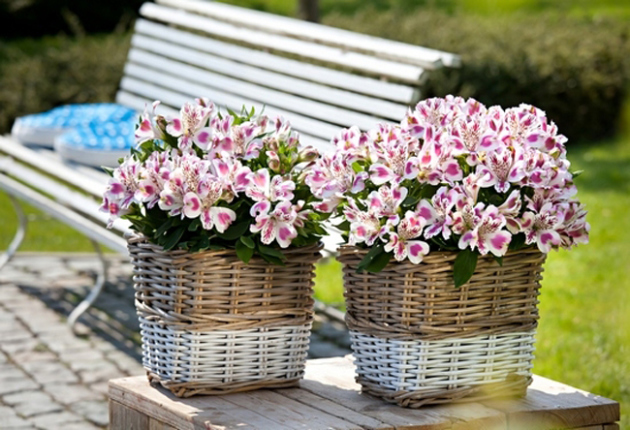
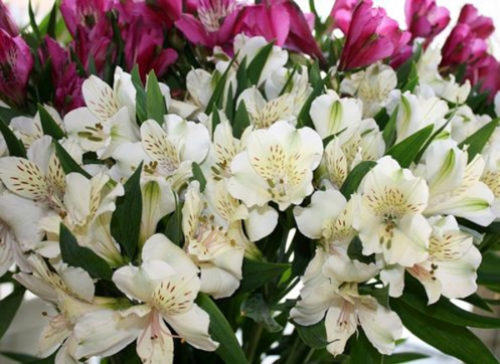
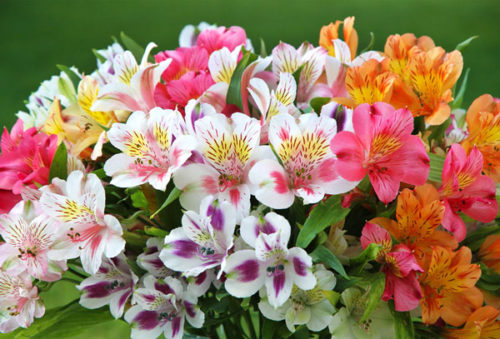
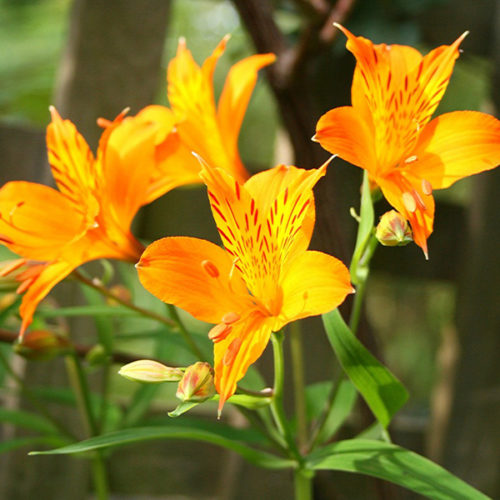
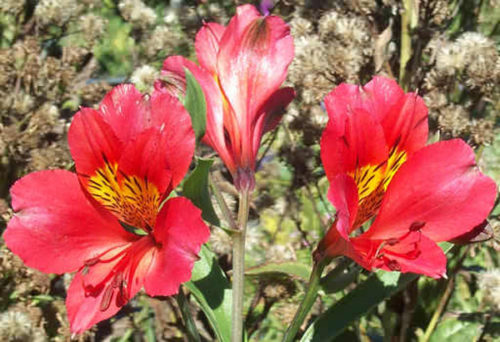

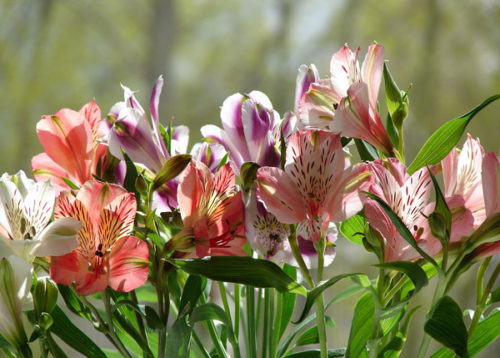
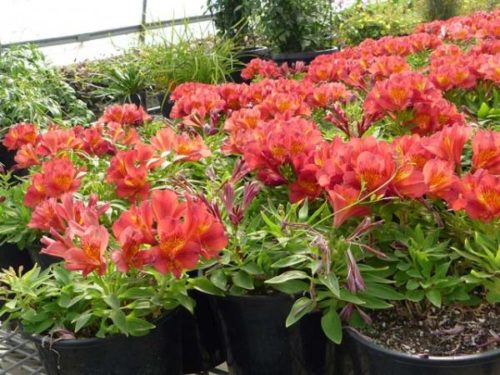

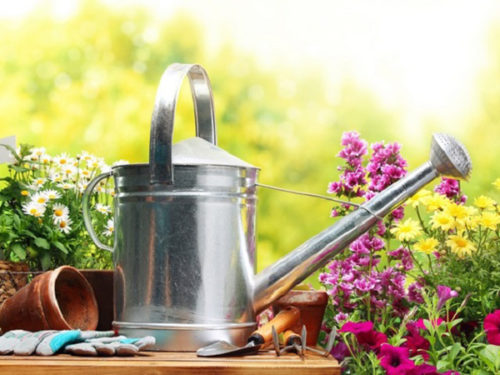

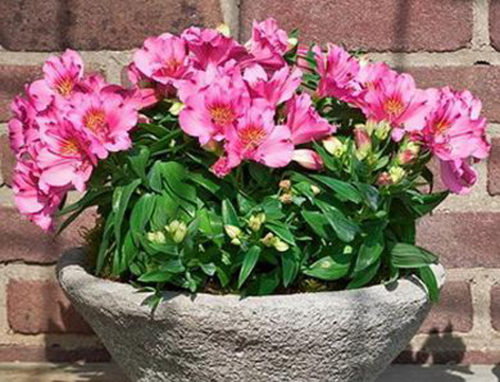
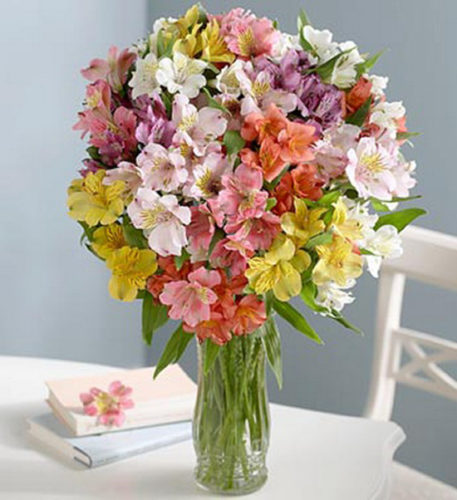

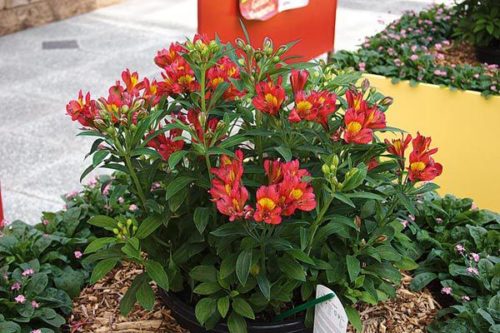













 Start a discussion ...
Start a discussion ...